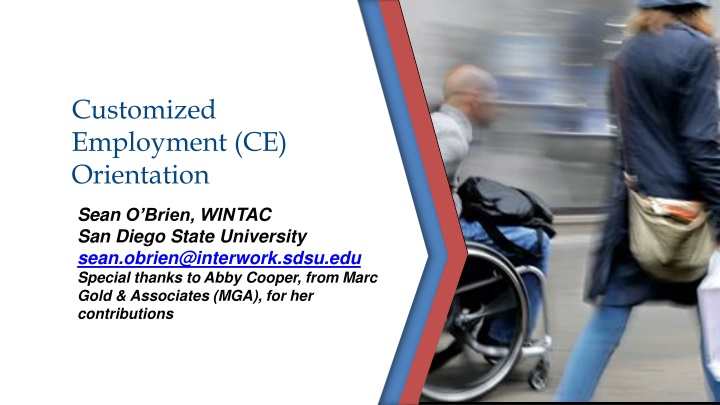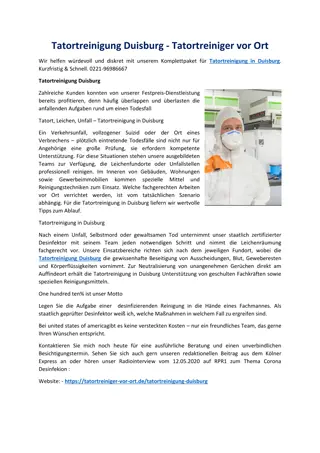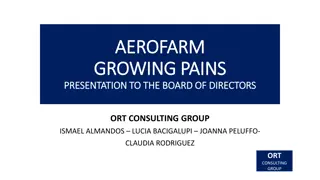
Customized Employment (CE) for Individuals with Disabilities
Learn about Customized Employment (CE) under the WIOA law, designed to provide competitive integrated employment for individuals with significant disabilities. Explore the flexible process of CE and its essential elements for personalized job matches between candidates and employers.
Download Presentation

Please find below an Image/Link to download the presentation.
The content on the website is provided AS IS for your information and personal use only. It may not be sold, licensed, or shared on other websites without obtaining consent from the author. If you encounter any issues during the download, it is possible that the publisher has removed the file from their server.
You are allowed to download the files provided on this website for personal or commercial use, subject to the condition that they are used lawfully. All files are the property of their respective owners.
The content on the website is provided AS IS for your information and personal use only. It may not be sold, licensed, or shared on other websites without obtaining consent from the author.
E N D
Presentation Transcript
Customized Employment (CE) Orientation Sean O Brien, WINTAC San Diego State University sean.obrien@interwork.sdsu.edu Special thanks to Abby Cooper, from Marc Gold & Associates (MGA), for her contributions
Welcome! What are we trying to accomplish? This presentation is intended to help gain a common understanding of Customized Employment (CE) Under the current Workforce Innovations and OpportunityAct (WIOA) law, CE is defined as competitive integrated employment, for an individual with a significant disability, that is: Based on an individualized determination of the unique strengths, needs, and interests of the individual with a significant disability; Designed to meet the specific abilities of the individual with a significant disability and the business needs of the employer; and 2
Customized Employment (CE) definition continued. CE is a flexible process designed to personalize the employment relationship between a job candidate and an employer in a way that meets the needs of both It is based on an individualized match between the strengths, conditions, and interests of a job candidate and the identified business needs of an employer The CE approach is typically reserved for those with the most significant disabilities and/or complexities WIOAlaw or regulations do not describe the CE process 3
The Essential Elements of Customized Employment In 2017, The Essential Elements of Customized Employment for UniversalApplication was established as the recognized document to identify the essential elements of customized employment (CE) as a guide for the universal application of these elements across service delivery and training providers. This document is available on the WINTAC website along with other CE resources; http://www.wintac.org/topic-areas/resources-and- strategies-for-competitive-integrated-employment We will be following this guidance as our primary reference during this CE orientation. It s also been adopted as the training foundation for high quality CE training 4
The Essential Elements of Customized Employment Negotiation of job Duties The job duties are set as a result of negotiation with employers Individualization, involving a job for one person Negotiated pay of at least the minimum wage CE occurs in businesses in the community or in businesses owned by the individual 5
The Essential Elements of Customized Employment CE facilitates mutually beneficial voluntary relationships where employer and consumer win Job development agents are used as necessary to represent the employment seeker Aqualitative no fail process that presumes that all individuals can work Customized self-employment or customized wage employment is chosen by the individual 6
Components of CE Discovery Documenting Discovery for CE Planning Negotiated job Job Seeker CE Planning Meeting
How is Customized Employment (CE) helpful? CE reveals what a person who may be viewed as unemployable CAN do and new possibilities that can address employer needs based on the discovery of the client s potential employment contributions This occurs through an intensive Discovery process that helps uncover the person s talents, capacities, contributions and conditions for successful employment that is utilized to facilitate a Customized Employment outcome 8
CUSTOMIZED vs SUPPORTED EMPLOYMENT (SE) DISTINCTIONS The CE process begins with an individualized and intensive Discovery process that may be 30+ hours or more in length CE requires individualized job development that closely follows what s been learned in that Discovery process PRIOR TO looking at any job or meeting with the employer Prior to representing the jobseeker you have learned who that person is through intensive Discovery Job Development is individualized you represent one job seeker at a time The job seekers determines how they will be represented to the employer 9
CUSTOMIZED vs SUPPORTED EMPLOYMENT (SE) DISTINCTIONS2 CE focuses at the beginning of the employment process through an intensive Discovery process that seeks to customize the relationship with employers for mutual value exchange Acustomized job is built based on what is found in the Discovery process Supported Employment focuses on the services needed to sustain successful employment after job placement that is typically labor market driven 10
CUSTOMIZED VS SUPPORTED EMPLOYMENT (SE) COMMON GROUND Both CE and SE outcomes are intended to result in competitive integrated employment: 1) Work occurs in an integrated, individualized work situation in the community 2) Employment results in pay at the prevailing wage or going rate Employment outcomes may include creating a job through self- employment Both utilize job carving, restructuring, modification, or creation Both may involve providing supported employment services 11
FOUR PATHWAYS RELATED TO SE & CE: 1) Some job seekers do not need either Supported Employment or Customized Employment 2) Some job Seekers will need Supported Employment to obtain and retain a job 3) Some job seekers need Customized Employment to obtain a job but do not need Supported Employment to retain the job 4) Some job seekers need Customized Employment to obtain a job and Supported Employment to retain the job 12
STEPS TO CUSTOMIZED EMPLOYMENT 1) Recruitment, intake, acceptance 2) Discovery 3) Capturing discovery through profiles 4) Customized Employment planning meeting 5) Concept Portfolio development (Agency) 6) Visual Resume (job seeker) 7) Job development 8) Job site analysis 9) Job negotiations 10)Job creation 11)Accommodations, Supports as needed 13
DISCOVERY; THE CORE OF CUSTOMIZED EMPLOYMENT Finds the direction to facilitate successful employment Allows us to gain insight or knowledge of something previously unseen or unknown; to notice or realize; to make known, reveal, disclose Requires letting go of assumptions and labels or at least holding them at bay 14
STEPS TO DISCOVERY Intake Scheduling a home visit Home Visit Benefit Discussion & Expectations Observation ofActivities Participation in FamiliarActivity Participation in NovelActivity Interviewing 15
DISCOVERY PROCESS Determine individual s strengths, needs, and interests as a result of the qualitative Discovery process Discovery strives to view the employment seeker descriptively rather than evaluatively and in typical aspects of their lives Discovery should include interviewing the employment seeker, the family/ natural supporters, and friends Discovery should include an optimistically focused review of records pertaining to the employment seeker 16
DISCOVERY PROCESS Allowing for sufficient time to complete the Discovery process is critical The Discovery findings should be detailed in a comprehensive, narrative document The Discovery document should identify the individual and their living situation, family, friends, and current life status including a description of the individual s life experiences The Discovery document such as the Discovery Profile or Discovering Personal Genius (referenced later) should provide preparation for the employment plan to customize employment options that is owned and approved by the consumer 17
DISCOVERY PROCESS Written in descriptive language providing the reader with a visual picture Captures all relevant aspects of the job seeker s life, including the complexity of their disability and solutions Capture the array of skills that will be used in job development efforts Collects the job seeker s conditions, interests and potential contributions for employment It translates possible tasks, pacing, learning styles supervision strategies to the work environment and tasks the jobseeker wants to do for pay 18
DISCOVERING TASK vs SKILL ABILITIES SKILLS are what an employer usually looks at when s/he hires you which are often listed on a job description but TASKS are what s/he pays for to get done. When we focus on tasks rather then formal job titles & descriptions, we start to see possibilities TASKS: are the steps of a performance activity. If I can describe how the work needs to be done in a series of concrete tasks, I can better align the functional abilities a person that we discover so both the employer and consumer are successful 19
DISCOVERING TASK vs SKILL ABILITIES If you can identify what TASKS a person can do: You expand and create more possibilities of what a person can do You start to see how they would bring value to the employer You see how those tasks can address an employer s need It can set direction for what employers should be approached 20
DISCOVERY & CUSTOMIZATION Discovery provides the foundation for planning It takes information for a job seekers entire life and translates that information into tasks a person can do for pay, environments that will highlight when they are at their best, and conditions needed to be successful The information obtain leads to a customized job 21
Discovery Results In Pulling Together AND TRANSLATING all the Complex Pieces Looks at when a person is at his/er best Daily Routine Friends Family Community Familiar Activities Novel Activities Conditions Supports Needed Tasks What will need to be negotiated
WHEN TO USE DISCOVERY T o Create belief that the jobseeker can obtain employment We do not know what a person can do competitively Often traditional assessments focus more on what a person can t do but not what they can do You really do not have a useful direction 23
THE WRITTEN DISCOVERY DOCUMENT MUST Paint a picture of: Who the person is T asks that be can done for pay Contributions to offer the employer What conditions are needed for success Elements that need to be negotiated with the employer 24
DISCOVERY MUST INFORM JOB DEVELOPMENT Structure of Duties predictable, use machinery, single task, more than one task, pacing of tasks Understanding type of environment inside/outside, pace, mood, noise is critical Learning style, communication style, conditions needed for the job seeker to be at his or her best 25
DISCOVERY REPORTING Describing Discovery is Essential Marc Gold andAssociates (MGA) Discovery Profile forms and examples can be accessed by clicking on their website below: http://www.marcgold.com/forms/ Griffin Hammis andAssociate s (HMA) Discovery Staging Record (DSR) available upon request; kyates@griffinhammis.com 26
VISUAL RESUME Avisual resume is a marketing tool for the job seeker that shows how the person may work through a series of pictures of the individual doing tasks It uses visual and narrative information developed during Discovery and the Customized Planning Meeting to present the job seeker in the best possible manner Used with employers to present the job seeker and customized employment in a manner that helps employers understand the process 27
PLANNING MEETING The Planning Meeting makes the connection between who is the job seeker to where employment could occur Creates a vision of where the job seeker might be at his or her best in a work setting Based on Discovery information identifies an individual s conditions for employment, individual preferences and potential contributions T asks to be performed, not job titles 28
PLANNING MEETING2 The meeting is about employment, not about the feasibility of if the person can work or not The meeting belongs to the individual The individual and the family should determine the timing of the meeting as well as those who should attend It is often necessary to determine who holds the trumps at the meeting 29
OUTCOME OF THE PLANNING MEETING Translation of the who is the Job Seeker in terms of employment: T asks to be performed Identified specific employers have a need for those tasks who will be contacted Ideal characteristics of employment: Conditions Interests Contributions What will need to be negotiated with an employer 30
A CLEAR EMPLOYMENT PATHWAY An individual list of potential tasks the job seeker offers the employer Aprioritized list of employers Names and connections to the employers T eam members with assigned duties to assist with job development 31
NEGOTIATING A JOB2 Present a proposal to the employer Be sure you are presenting to the right person(s) Can be written or verbal Explain how what your proposing meets the needs Demonstrate impact on workflow or employees Explain supports you will provide Ask the employer for his or her feedback Share your mutual concerns Problem solve together 32
Roles Payer (VRC, etc) Job Seeker Job Seeker willing to go through the process Keeps VRC/payer Informed Jobseeker not jump to any job Provider Observe job seeker Take descriptive notes Interview people who know the job seeker Submit logs to VRC Write a positive, descriptive Discovery document Negotiated job Determines who receives Discovery Explains CE to the Job Seeker Monitors Discovery Expects a direction for Employment Reviews Discovery Information, can the VRC plan from it?
EMPLOYERS AND THE VALUE EXCHANGE What s in it for them? How do we help them see possibilities that will improve their business? How do we present the business case? How can we make this a useful value exchange? 34
IDENTIFYING EMPLOYERS UNMET NEEDS This process can be conducted in three ways: 1. As a part of individualized job development, during the tour, one employer at a time 2. As a part of informational, discovery interviews with employers, concurrent with individualized job development 3. As a part of general activity in the community by job developers, family members and job seekers 35
IDENTIFYING EMPLOYERS UNMET NEEDS2 T arget employees performing job tasks to identify possible areas that might need additional support: Episodic duties T asks better performed by others at a lower pay grade T asks needing additional production assistance Back-ups/Bottlenecks Material/tool supply Interruptions Wasted motions 36
WORKSITE ENVIONMENTAL ASPECTS Notice issues that may lead to identifying employer unmet needs: Unattended materials/documents Waste/scrap materials Consistent errors Misplaced materials/goods Dusty, broken, dirty goods/materials Missed opportunities 37
WORKSITE CUSTOMER SERVICE ASPECTS Focus on customers who use the business: Customers waiting Customers confused Customers needing specific information Customers angry or with complaints Customers needing assistance Unsafe or unsightly conditions 38
WORK ENVIRONMENT Pay attention to: How people communicate The pacing in the environment Noise level Level of supervision Style of supervision Do people appear to help each other? Open doors when someone is carrying items Ask people if they need help Do people take breaks together? 39
ENVIRONMENTAL ANALYSIS Who supports whom? Type of the support people receive Location of Support & information Who is in charge and who is listened to? How is feedback given and received? What standards are people measured by? Type of communication/ social interactions 40
EMPLOYER ENGAGEMENT Engage employer in a self-analysis of the workplace. Ask employer to consider: Unmet needs Things that need to get done that are not getting done T asks better performed by others at a lower pay grade T asks needing specific productivity assistance 41
BEFORE A CUSTOMIZED JOB IS PROPOSED MUST KNOW: How the person s contributions meets the employer s needs How the employer s culture can meet the jobseeker s conditions How the job seeker will meet employer s conditions How the job seeker adds value for the employer 42
BEFORE A CUSTOMIZED JOB IS PROPOSED Be sure you understand the impact of your suggested changes AND you know why it is good for the employer (value exchange) How does it saves money? How does it improve the work flow? Improves efficiency? 43
Contacts Sean O Brien, WINTAC sean.obrien@interwork.sdsu.edu Chip Kenney, WINTAC chipkenney@interwork.sdsu.edu




